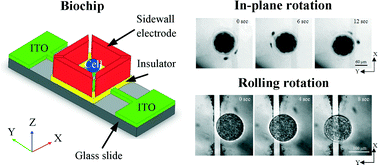AC electric field induced dipole-based on-chip 3D cell rotation†
Abstract
The precise rotation of suspended cells is one of the many fundamental manipulations used in a wide range of biotechnological applications such as cell injection and enucleation in nuclear transfer (NT) cloning. Noticeably scarce among the existing rotation techniques is the three-dimensional (3D) rotation of cells on a single chip. Here we present an alternating current (ac) induced electric field-based biochip platform, which has an open-top sub-mm square chamber enclosed by four sidewall electrodes and two bottom electrodes, to achieve rotation about the two axes, thus 3D cell rotation. By applying an ac potential to the four sidewall electrodes, an in-plane (yaw) rotating electric field is generated and in-plane rotation is achieved. Similarly, by applying an ac potential to two opposite sidewall electrodes and the two bottom electrodes, an out-of-plane (pitch) rotating electric field is generated and rolling rotation is achieved. As a prompt proof-of-concept, bottom electrodes were constructed with transparent indium tin oxide (ITO) using the standard lift-off process and the sidewall electrodes were constructed using a low-cost micro-milling process and then assembled to form the chip. Through experiments, we demonstrate rotation of bovine oocytes of ~120 μm diameter about two axes, with the capability of controlling the rotation direction and the rate for each axis through control of the ac potential amplitude, frequency, and phase shift, and cell medium conductivity. The maximum observed rotation rate reached nearly 140° s−1, while a consistent rotation rate reached up to 40° s−1. Rotation rate spectra for zona pellucida-intact and zona pellucida-free oocytes were further compared and found to have no effective difference. This simple, transparent, cheap-to-manufacture, and open-top platform allows additional functional modules to be integrated to become a more powerful cell manipulation system.

- This article is part of the themed collection: 2014 Lab on a Chip Emerging Investigators

 Please wait while we load your content...
Please wait while we load your content...